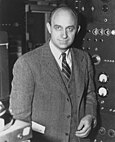Portal:Chicago/Selected biography/163
Enrico Fermi (1901 – 1954) was an Italian physicist, known for his work on Chicago Pile-1 (the first nuclear reactor) and his contributions to quantum theory, nuclear and particle physics, and statistical mechanics. He is one of the men referred to as the "father of the atomic bomb". Fermi was awarded the 1938 Nobel Prize in Physics for his work on induced radioactivity by neutron bombardment and the discovery of transuranic elements. He was widely regarded as one of the very few physicists to excel both theoretically and experimentally. After Wolfgang Pauli announced his exclusion principle in 1925, Fermi applied the principle to an ideal gas, employing Fermi–Dirac statistics. Fermi developed a model that incorporated Pauli's postulated invisible beta decay particle, named the "neutrino". Fermi's interaction theory described one of the four fundamental forces of nature. Inducing radioactivity with neutrons, developed the Fermi age equation. After bombarding thorium and uranium with slow neutrons, he concluded that he had created new elements; although he was awarded the Nobel Prize for this discovery, the new elements were subsequently revealed to be fission products. In 1938, he escaped new Italian Racial Laws against his Jewish wife. In the United States, he worked on the Manhattan Project during World War II. Fermi's team designed and built Chicago Pile-1, that went critical on 2 December 1942, demonstrating the first artificial self-sustaining nuclear chain reaction. At Los Alamos he headed F Division, part of which worked on Edward Teller's thermonuclear "Super" bomb. At the July 1945 Trinity test, his Fermi method estimated the bomb's yield. After the war, Fermi served under Oppenheimer on the influential General Advisory Committee of the Atomic Energy Commission. Following the first Soviet fission bomb detonation in August 1949, he opposed the hydrogen bomb. Fermi did particle physics work related to pions and muons, and he speculated that cosmic rays arose through material being accelerated by magnetic fields in interstellar space.

